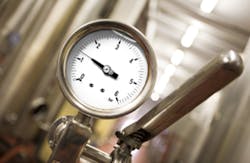Portable, hydraulic comparators and hand pumps make high-pressure field and lab calibrations fast, easy, and relatively safe. Compared to pneumatic pressure sources, hydraulic calibration offers advantages in portability, safety, and the easy achievement of high pressures in remote locations. Stacked against these advantages, hydraulic calibrations demand careful procedures in order to enable stable measurements and achieve acceptable accuracy. A variety of best practices exist to mitigate the impact of adiabatic effects—also known as thermodynamic effects—which disrupt stability in a hydraulic system.
All hydraulic hand pumps and comparator systems experience an adiabatic effect upon reaching target pressure. This effect is characterized by an immediate drift away from the target pressure, caused by the rapid temperature change of the small pockets of air that remain in the fluid-filled system, as well as the gradual temperature change of the hydraulic fluid itself.
As system pressure increases, the temperature of the hydraulic fluid increases. The small volumes of trapped air quickly compress and heat as well. Once the pressure increase stops, the pockets of air release their heat into the surrounding materials and the hydraulic fluid begins to cool, causing a noticeable drop in system pressure.
Proper procedures for assembling a hydraulic system and conducting a hydraulic calibration focus on minimizing the impact of adiabatic effects. Follow these best practices to diminish adiabatic effects.
1. Change system pressure gradually:
- Increase system pressure slowly to minimize the adiabatic pressure drop.
- Decrease system pressure slowly to minimize the adiabatic pressure increase.
2. Reduce air in the system while connecting:
- Connect all the required fittings and connectors to the pressure source.
- Elevate one or both pressure ports above the remainder of the pressure source.
- Apply pressure until test fluid fills the top of the pressure port and connected fittings.
- Connect the device-under-test or reference gauge.
- Repeat for the remaining device and pressure port.
3. Use purpose-designed test & calibration fittings as bleed points:
- If the system includes test & calibration fittings with a self-venting weep hole, locate these fittings as close to the measurement devices as possible, and use them as a bleed point.
- Once the reference gauge and device-under-test are securely connected, apply a low-pressure system pressure (10 PSI to 15 PSI).
- Loosen one calibration and test fitting near the device-under-test or reference gauge until air and test fluid escape from the weep hole, then re-tighten.
- Repeat this procedure for the remaining pressure device.
4. Choose water instead of oil:
- Use water as the hydraulic fluid, instead of oil. A system using water as the hydraulic fluid shows a pressure change rate that is two times lower than the same system using oil.
5. Limit hose expansion:
- Even the best flexible hose will double the pressure change rate. This is caused by hose expansion, which allows an increase in volume and a resulting decrease in pressure. Use steel tubing for optimal stability.
6. Limit heat transfer:
- Excessive handling will warm the fittings and connections, which amplifies the adiabatic effect. Wearing gloves while handling connectors and fittings is advisable.
- A falling ambient temperature, or moving the test from a hot area into a cold area will also amplify the adiabatic effect.
To take advantage of adiabatic effects during a calibration, follow this outlined procedure:
- Connect the reference gauge and enable the peak capturing mode.
- Starting at a vented condition, slowly increase pressure.
- Observe the increasing pressure on the device-under-test (not on the reference gauge, as during a typical calibration).
- Taking special care not to exceed the target pressure, stop increasing pressure immediately upon reaching the target pressure. The adiabatic effect will now allow system pressure to drop, causing a maximum peak pressure that the reference gauge will capture.
- Take a reading for that target pressure from the reference gauge.
- Continue increasing pressure and repeat these steps for each ascending target pressure.
- For descending target pressure readings, enable low-peak capturing on the reference gauge and repeat this procedure. The adiabatic effect at each target point will cause system pressure to rise, causing a maximum low-peak pressure that the reference gauge will capture.
In this manner, users find it possible to decrease the time required for an up and down calibration to 10 minutes or less. Using a specialized reference gauge that connects to calibration software, users can automatically record points directly to a calibration database, reducing the time required for the same calibration to less than 3 minutes. This method can only be recommended for process gauges, transmitters, and other devices which do not demand extremely high levels of accuracy.
Adiabatic effects can cause significant instability in hydraulic pressure calibration systems. Using proper connection procedures and materials, ensuring that air is bled from the system as much as possible, and that pressure changes occur gradually will help limit the pressure change rate due to an adiabatic effect. Alternatively, by employing the proper equipment and procedures, users may take advantage of adiabatic effects to reduce hydraulic calibration time.
Patrick Klima, is the technical writer at Crystal Engineering. After majoring in Mechanical Engineering at California Polytechnic State University, he wrote technical material and articles for a variety of industries, including energy management and green construction. His articles on pressure measurement solutions and digital pressure gauges have been published in a variety of trade magazines, including two previous appearances in Flow Control magazine. He can be reached at 800 444-1850.




